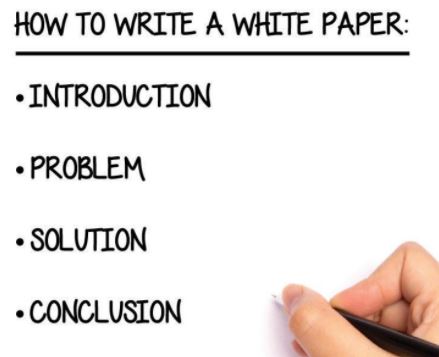A white paper is one of the most powerful marketing tools of any company. Companies use this tool to share the worth of their product and service with their potential customers. Your white paper can put your business on the map for potential customers researching their options, increase the efficiency of the different stages of your sales funnel, and create trust with a casual reader.
The white paper of any business or company should deliver insightful, useful, and excellent content to the reader. The presentation of the white paper should also capture the attention of the reader. However, the effectiveness of your white paper depends on how you write it.
Writing a white paper is a very challenging task. If you do not do it the right way, you will end up dishing out boring content that will not appeal to the interest of your readers and potential customers. When your white paper is created with the right format, it would help to solve issues for your stakeholders and clients, boost your authority, and serve as a very powerful lead magnet.
How do I write a white paper? What is the right white paper format? In this article, we will teach you the ideal white paper format. We will walk you through everything you need to know about white papers and how you can write an efficient one that will take your business to the next level.
What Is a White Paper ?
A white paper is a comprehensive guide or report about a specific topic as well as the issues surrounding it. Marketing agencies and companies usually create these reports about complex issues that their customers face. The report is aimed at educating the readers, helping to understand the problem and to solve it.
 Photo: technologyadvice.com
Photo: technologyadvice.com
White papers are research-based and persuasive, and many companies use them as an inbound marketing strategy. This document usually presents the philosophy of a company to potential customers, establishing expertise and authority on a specific issue and solution.
In other words, white papers help readers to understand a problem, solve an issue, or make a decision. A white paper is a text-heavy, data-centric business document. These documents are deep reads and often have a formal tone because of the enormous amount of research and data.
When it comes to marketing, a white paper is like an eBook, but slightly different because it is more in-depth and technical. All the opinions and facts highlighted in a whitepaper are usually backed by statistics and research. They usually include tables, graphs, charts, and other data visualization methods.
White Paper Uses
Companies write white papers to market themselves and to record expertise. They often give out white papers to leads who have shown interest in the services or products of a company such as clients, stakeholders, and B2B buyers.
As we said earlier, white papers are a very powerful tool, and they are written for readers outside of the company. Companies and businesses use this tool to attract readers to their products or services. Here are the two major uses of white papers:
Case Study
Most times, many businesses create very long case studies as white papers. This could be a story about a company, the obstacles it encountered, and how the product or services of the company helped them to resolve an issue. They use white papers to give people more information about their products and/or services.
It usually contains technical and detailed information, and it makes customers/clients see themselves using the product. A case study helps to provide real-world examples of how companies are helping their clients to achieve success.
Reference
A white paper contains plenty of details, and they are very lengthy. They usually contain a lot of information that, sometimes, the customer does not really need. Nevertheless, other companies and businesses in the industry can use them as a reference guide to enhancing their business.
White Paper Format
 Photo: ecija.com
Photo: ecija.com
The format of your white paper is one of the most important things you need to consider when writing it. Before you start writing, you need to make an outline and choose the format you want to use. When it comes to writing white papers, there are many formats out there, with little differences based on industry and topic.
A white paper usually follows the format of a standard document. The order of the content might seem similar to other types of business reports. However, there is one major difference, and that is the position of the conclusion. For white papers, the conclusion is usually at the end.
Many business documents, like proposals and technical reports, have the main conclusion at the starting of the document. This order is based on what the readers what, as well as their preference in getting the information. When it comes to white papers, the research and content inform the readers and make them to better understand the issue all through the document.
The last section is what contains the final recipes of the document. It wraps the entire document up, and it is where the reader gets the solution that the evidence in the document supports. The preferences and journey of the reader in a business are different from that of a white paper.

Photo: contentcreatorz.com
Here is the basic structure of a white paper:
⓵ Introduction
Like every other document, a white paper also starts with an introduction. The introduction contains the highlight of the entire document. It contains brief information about the major points that the white paper is made of. It is from the introduction that the customers will determine if the content in the white paper is relevant to them.
⓶ Statement of the Problem
After the introduction, the statement of the problem will come next. This is where you state the specific problems that customers are facing that the white paper will address. You need to make sure that the problem stated is in line with the service or product that you are offering. The problem statement also needs to be very clear to avoid any misunderstanding.
⓷ Information
The most crucial part of a white paper is the information section. The information section is where you tie the problem statement and introduction together. It is also where you talk about the product or service and all its offerings and features. It is the information that will lay the foundation for the introduction of the solution.
⓸ The Solution
As the title implies, the solution section presents the solution of the problem to the reader. This is where you will talk about the service or product that will be of use to the reader. It contains a detailed explanation of how the reader will benefit from the service or product. The solution has to be relevant and useful. In addition to being relevant, the solution needs to be backed by evidence to support every claim the white paper contains. This section of the white paper needs to contain both qualitative and quantitative information.
⓹ The Conclusion
The final part of the white paper is the conclusion. As we said earlier, the conclusion of a white paper is at the end of the document, which is one of the major differences between a white paper and most business reports. This is the section where you summarize and round up the whole white paper. The conclusion can also contain a list of some vital takeaway points (bulleted).
Simple Steps to Writing an Outstanding White Paper
Many business owners have been looking for new and improved ways to attract new customers and take their business to the next level. For your business to grow, you need to learn how to attract potential customers and convert them into loyal and returning customers.
Most businesses start by increasing the awareness of their business by providing potential customers with fascinating, useful, and engaging content such as videos, posts, ebooks, infographics, and more. However, one of the most common forms of content that have been creating waves, especially in the B2B industry, is a white paper.
Undoubtedly, white papers are highly effective when it comes to sourcing for new prospects. However, for you to get the most of a white paper, you need to know how to do it right. Knowing the fundamentals, techniques, and tricks of writing a white paper is very important, as it is what would determine the success of the white paper.
When you write and format a white paper the right way, it can fetch you new customers and convince them to consider your services or product. For a white paper to attract an audience, it needs to provide relevant information that would be useful to the reader. It needs to be interesting enough to convince the reader to patronize your product or service. Here are some simple steps to help you write an outstanding white paper.
① Pick a Valuable White Paper Topic
The first step to writing a relevant white paper is coming up with a valuable topic. You need to think of a very good topic area. The topic should be relevant, eye-catching, and partially reveal what the content of the white paper is about.
Your white paper should be unique; it should discuss a topic that has not been addressed in the industry. Your white paper can also be an improvement or a better version of a topic that has been addressed before in the industry.
You can get an idea of what your topic would be by looking at white paper templates or white paper examples of what your competitors have done. Think about the common issues you have in your niche or industry and study content related to your industry such as webinars, blog posts, podcasts, and videos.
You need to be specific about the topic. Writing about a broader topic will throw many readers off the hook. The content needs to be authoritative, which is why it is important to write about a topic that you have knowledge and experience in.
When determining your topic, you also need to consider the goals you want to achieve. Are you looking for authority or more brand awareness? Do you just want to convert researchers into buyers? The answers to these questions will help you streamline your topic, making it easy for you to write a valuable topic.
② Determine Your Target Audience
Remember, you are not writing the white paper for yourself but your target audience. As such, the content of your white paper should be in line with the needs and wants of your audience. You need to have a target audience in mind – the people that are going to read your white paper.
If you know who your target audience is, it would be easy for you to tailor the white paper to suit their needs. Knowing your audience will help you to determine the kind of solution you are going to provide as well as how you will present it to them when you are done.
③ Determine Your Objectives
One of the best ways to remain focused when writing a white paper is to determine your objectives of making the white paper. Is the white paper for building your brand, generating more leads, predicting the future of the industry, or educating your audience?
You need to determine what type of white paper you want to create, as this would help you to stay in course. It would prevent any deviation and help you stay focused on the main aim of the document. You should also have metrics to identify the failure and success of your white paper.
④ Conduct Extensive Research
Regardless of how much you know about the topic you want to write about, you need to back everything up with hard facts and statistics. This is why you need to conduct extensive research before you start writing your white paper.
You should carry out research using reliable sources such as the Bureau of Labor Statistics to get demographic information. If you are researching the marketing industry, you can rely on sources like Forrester.
Make sure you look for accurate and reliable data and information in your industry via standard, reliable, and acceptable sources. As we said earlier, a white paper often contains many proven facts, statistics, and data, and you need to get all of these from reliable sources.
⑤ Create an Alluring Title of Headline
After picking the topic area, determining your target audience, and stating your objectives, the next thing is to come up with an alluring, charming title or headline. The headline should include what the white paper is meant to solve as well as what readers will benefit from it.
The headline should be a little bit descriptive. It should let the readers know what is contained in the white paper before they start reading.
⑥ Your Outline and Format
Before you start writing, you should make an outline and decide on the format to use. There are many white paper formats out there, but they all have many things in common. The slight differences between them are the industry and topic. You can use the format stated above or look at your white papers published by your competitors to see the format they used.
⑦ Avoid Using Promotional Languages
After putting everything in place, including making your outline, the next thing is to start writing the white paper. When writing, you should not use promotional language. Your focus should only be to create value for your target audience. You need to provide them with what they want to hear by thinking about what they need and want.
Steer clear of making claims without strong evidence. You should back up all claims with reliable information and statistics from trusted sources.
⑧ Use Visuals
The design of the white paper is another vital thing to consider, and it would play a key role in the success of the white paper. To make it more appealing to read, you should use images, blurbs, callouts, charts, and graphs to give your readers a clear representation of what you are talking about or trying to prove. You can also use them to create infographics to market and distribute the white paper. This will help the reader to better understand the company’s white paper.
⑨ Use Realistic Examples
Another great way to catch the attention of your readers and to convert them into loyal customers is to use real-life examples. Using real-life stories and examples would make your central theme as well as your suggested solution more authentic. As such, you should spice up the document with real-life examples, case studies, scenarios, and more.
⑩ Marketing
Another vital thing you should consider is how you want to market the white paper to your audience. You can market it through emails, launching their conferences and events, banners in online publications and magazines, social media posts, hosting webinars, and more.
After writing the white paper, you have to convert it to a PDF. One of the easiest ways to market it is via a landing page. You can get basic data from customers such as their email addresses and name. You can convince them to do this by making the landing page of your white paper very attractive. It should have an image of the white paper’s cover page together with an executive summary of the white paper.
You need to show potential customers what they will get in exchange for their information. Show them what they will learn and benefit from downloading the white paper. Once you get the details you need, you can start pushing the downloadable PDF to them.
Mistakes You Should Avoid When Writing a White Paper
Everyone is bound to mistakes, and learning from other people’s mistakes is one of the best ways to avoid mistakes. When writing a white paper, there are some mistakes and pitfalls that you should avoid. Here is a brief list of the mistakes you should avoid:
⫸ Lack of Proper Research
You should avoid writing a white paper that is not researched properly. A white paper should be an adequately researched document. While carrying out lengthy and extensive research might be a little bit above the budget of a marketing team, you should not let that stop you from conducting thorough research at all.
Your white paper should contain some very useful and relevant statistics from highly reliable sources. The research work might also be time-consuming, but it is worth it. It would give your readers concrete proof that you know what you are talking about. Make sure your facts, stats, and data are from authoritative sources.
⫸ Making It Sound Like a Sales Pitch
Another mistake you should avoid is making the white paper sound like a sales pitch. Doing that will turn your audience off immediately. What your readers want to see in the white paper is educational, truthful, realistic, and unbiased information that can solve a problem they are facing. They are not looking for something that does not hold any value or persuade them.
⫸ Bad Design
People love flashy and attractive things, and white papers are not an exception. While the written content is the most crucial part of a white paper, the design also plays a very important role. Your white paper content might be great, but if your design is poor, most of your audience will not read it. Hence, you should not neglect the design of the white paper.
The design of the white paper will help to bring your points, research, and info. It would make your document stand out and very easy to understand. The document should have a good design, with the perfect display and positioning of colors, images, charts, graphs, and more. You should also make sure that the design and graphics you use complements the arguments of the document.
⫸ Leaving It in the Realm of Theory
Since white papers involve sharing research work, most people make the mistake of leaving them in abstract forms without providing detailed explanations. To avoid this mistake, you should always provide a detailed explanation on how to use those research findings on a practical level. You should have a good amount of content in the white paper that explains the problem you are trying to solve.
⫸ Not Telling Stories
A white paper should be based on facts and information. We have talked about this already. Nevertheless, you should avoid telling boring or bad stories. Regardless of the type of white paper you are writing, you should have a story to tell. It would even be difficult for readers to read the entire content without any sort of story to keep them engaged.
When you spot the problem and introduce the solution, you should also add some form of a success story to prove your research and spice things up. You should make sure the readers do not get bored when reading the white paper, as that is what will keep them going.
What Makes White Paper Different ?
White papers are different from other types of business reports and advertising because their fundamental goal is to provide education and information to readers instead of making sales. Some of the things they have in common with other forms of advertising include colors, images, graphics, and videos. The major difference lies in the in-depth research and writing involved in the creation of a white paper.
 Photo: editorgroup.com
Photo: editorgroup.com
Some white papers can be very lengthy, up to 100 pages or more. Some businesses also adopt creative designs to help maintain the interest of the audience as they read the document.
Final Thoughts
White papers are very useful and important to many companies and businesses. Nevertheless, writing a good and valuable white paper is not an easy task. You need to invest a lot of time, resources, and hard work into it. While many companies outsource this task to a professional writer, some do the research and write their white paper themselves. For you to write a good white paper, you need to use the right formatting, pick the right topic, know your audience, do extensive research, and creative design. If you want to use a white paper template, there are many white paper examples out there that you can use.
The post 10 Steps to Writing the Best White Paper Format appeared first on Dumb Little Man.
